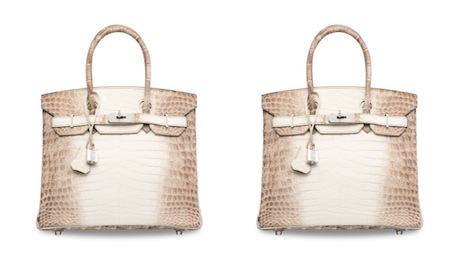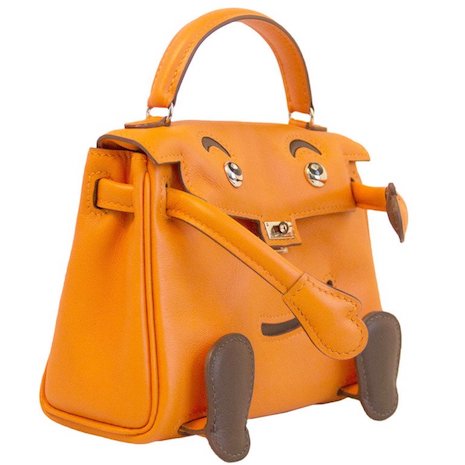 Hermès Himalayan Niloticus Birkin, sold at auction by Christie's
Hermès Himalayan Niloticus Birkin, sold at auction by Christie's MUSCAT, Oman – Although one of the newest categories offered by the 250-year-old auction house, Christie’s rare and vintage handbag department has become one of its most profitable.
The handbag department at Christie’s boasts the youngest buyers, the most female clients at 55 percent and the highest spend, totaling approximately $20 million for 2016 sales. Rare and vintage handbags have emerged as a financial and emotional investment for consumers around the world, with high-ticket bids being placed from clients based in the Middle East and Asia.
"We have to give credit to Christie’s," said Matthew Rubinger, senior director of Christie’s. "[The auctioneer] was the first mover in this area in 1978 with the private collection of Gabrielle 'Coco' Chanel.
"In fact, that was the first designer handbag to be sold at auction," he said. "The first designer handbag ever sold was a Chanel navy blue Flap Bag.
"Interestingly, the buyer was the Smithsonian Institute, which I think was a really interesting element for how this market got kicked off."
Got it in the bag
The Smithsonian Institute's 1978 purchase of Ms. Chanel’s purse, which occurred after the designer had died years earlier in 1971, served as an early indicator of the category’s investment potential, sentimental, cultural or financial.
Decades later, Christie’s set a world record for a rare Hermès Birkin handbag in 2016.
The Hermès matte white Himalayan Niloticus Crocodile Diamond Birkin 30 was part of the May 2016 lot, and was expected to sell for between $190,000 and $260,000.
Created in 2008 and retailed in 2009, the Himalaya Niloticus Birkin is the rarest, most sought-after and most valuable handbag in existence. The May 2016 auction marked the first time a handbag of this caliber was auctioned in Asia.
Hermès Himalayan Niloticus Birkin
This particular type of Hermès Birkin is produced in limited supply, with only one or two created each year. The 30 millimeter handbag features a matte white colored crocodile leather and has 18-carat white gold and diamond hardware.
The Birkin was sold at auction to a private Middle Eastern collector for $300,168. Prior to the auction, Christie’s Hermès Birkin sale record was $223,000 (see story).
At the Conde Nast International “Mindful Luxury” conference April 6, Mr. Rubinger stressed the importance of world record auctions for Christie’s, explaining that they are not just for bragging rights but are a means of attraction.
If a current world record is broken, market growth and confidence is spurred and sellers with the best pieces are attracted to go to auction.
Prior to 2010, Christie’s had placed rare and vintage handbags with its fashion lots such as celebrity dress collections or heritage costumes. Now, handbags are featured alongside jewelry and timepiece auctions because these hard-to-come-by pieces are not accessories, but rather investment-grade objets d'art.
Christie’s is not trying to consign every handbag created by high-end designers as a secondhand retailer would. Instead the auction house specializes in niche collector pieces.
These pieces fall into three categories. The first is rare handbags using complicated production techniques such as the aforementioned Himalayan Hermès Birkin.
Secondly, unique limited-editions are often up for auction, such as the Hermès' Kelly Doll circa 2000, which went to market for about 1,000 euros at launch, but resells for upwards of $15,000 in the collector market. The rarest kind of Kelly Doll, in pink leather, recently sold for $25,000 .
The limited-edition Hermès' Kelly Doll, circa 2000
Lastly, there are provenance lots that have a compelling history tied to a well-known figure, which often creates an unpredictable and unique narrative for the auction.
For example, Christie's Elizabeth Taylor auction was the most-valuable single-owner collection of handbags and accessories ever sold. A Louis Vuitton luggage set included in the auction collection was estimated to sell for between $3,000 and $5,000 but was bought for more than $100,000.
Christie’s handbag department also works with brands on their archives, back-end historical research, authenticity and partnerships.
Brand partnerships have included three one-off Armadillo boots by Alexander McQueen sold at auction after the Metropolitan Museum exhibit and limited-edition leather jackets embellished by designers in partnership with retailer Barneys New York for a charitable initiative (see story).
Collectors or not
A Christie’s client often does not consider herself a collector, even if she has 75 Birkin bags in her closet, as Mr. Rubinger jokingly suggested. Instead, the client is looking for a special piece for herself or a unique gift.
The client relationship is important to cull potential purchasers. Using the Middle Eastern region as an example, Mr. Rubigner explained that the local consumer demographic is very engaged and places an importance on relationships and trust.
Due to regional culture, Christie’s, which just celebrated a decade in Dubai, United Arab Emirates, opts for more events and educational programing in the Middle East than it does mailers, for instance. These experiential marketing tactics instill trust and build the foundations of a relationship with clients.
Christie’s Middle Eastern buyers account for only 2.2 percent overall, but in its luxury categories the percentage jumps to 5 percent.
These clients are well-connected, with social media being hugely important, as well as tech-savvy, well-educated and traveled, and they prefer very special, unique pieces. Combined, these characteristics fit very well with the auction model.
"I see [mindful luxury] from two separate angles. The first is us looking at our clients. We have to be more mindful of our clients than we have been in the past," Mr. Rubinger said. "The old luxury angle, particularly in emerging markets, of ‘If we build it, they will come,’ really does not work anymore. We really have to understand what it is they are looking for and have relationships with these clients to make sure that we’re there.
"The second piece is related, and makes the first piece a little more difficult, is how mindful today’s luxury consumer is," he said. "Today’s consumer is very well-traveled, well-educated, savvy and has access to everything in the world.
"It is important for us that we are offering them something extraordinary, something unique. At Christie’s, what that really means is a combination of a spectacular item, spectacular experience, spectacular client services and our unique version of expertise. It is a bundle of all that that comes together with our offering."

